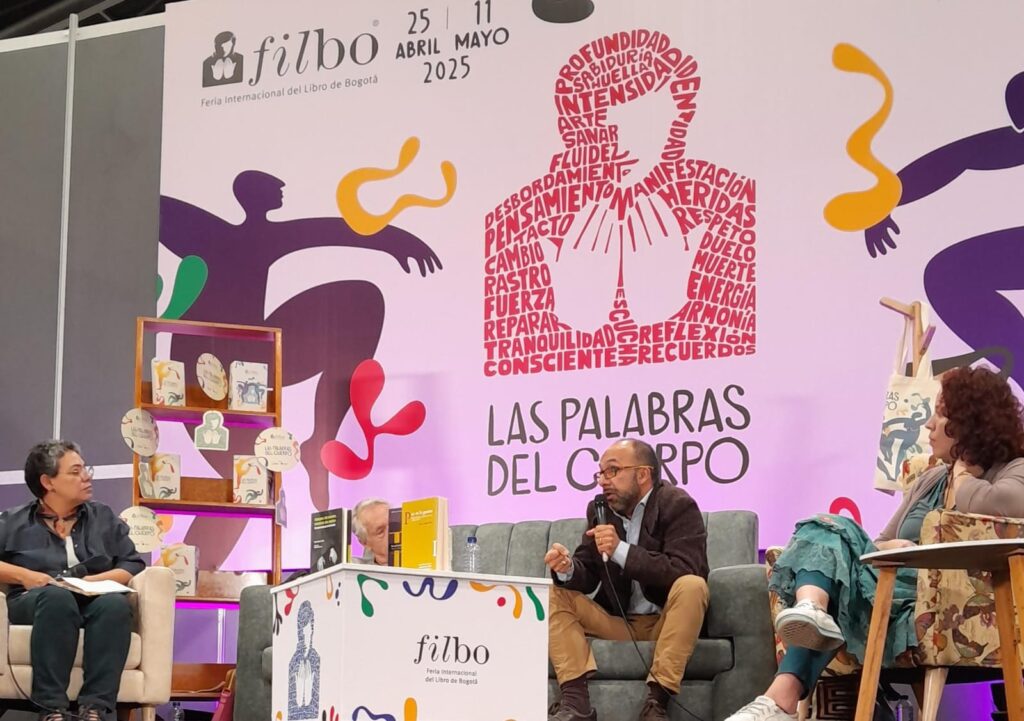FILBo 2025: Panel discusses the way violence and conquest imprint themselves on people’s bodies.
Ángela Forero-Aponte

If not every body matters, will we be able to attain peace? This was the question raised when Paola Uparela (assistant professor of Hispanic Literature), Maria Victoria Uribe (anthropologist and historian), and Juan Pablo Aranguren (psychologist) got together in FILBo 2025.
What became very clear in an intense panel is that not every body matters in every context. This is particularly true in the armed conflict in Colombia, where, despite the many known atrocities, there are still more we have yet to hear of. There are too many cases where people, and their bodies, are neither respected nor dignified.
Maria Victoria Uribe has done extensive research on the harm inflicted on bodies and how it is part of war. Aranguren wrote Las Inscripciones de la Guerra en el Cuerpo de los Jóvenes Excombatientes, among many other publications; Uparela is a specialist in Colonial and Transatlantic Latin American cultural studies, gender, sexuality, and queer studies at the University of Florida.
Professor Uribe began by asking what the definition of peace is. “We all talk about peace,” she said, but “how do we define it?” Peace is not necessarily a concept; it is a desire – one that she points out is not universal.
Peace to people in Gaza might mean no more bombardments; the idea of peace for a Buddhist monk in Thailand may be something completely different. Peace is a desire, and when we talk about peace, we need to consider our understanding of the word.
Professor Aranguren says we probably, wrongly, understand peace as the passage into a calm state after the war. But in the Colombian context, we need to consider the way war wounds and marks. The challenge when talking about peace is to analyse how war has been imbued in our daily lives.
We need to think about how war has been incorporated into a country with a long history of conflict. It isn’t only imprinted on those directly involved – whether victim or combatant — but also on those of us who are “comfortably” seated on a chair as mere spectators.
Professor Uparela says it is important to realize how the Spanish conquest of Latin America should not only be analysed from the context of the conquering of the territories, but from the conquest of those territories through the bodies. That encompasses the way conquerors rule, evangelize, and rape bodies.
It is also important to analyse the way written tools are used to own said bodies. A clear example is how the inhabitants of conquered regions were considered human only if they allowed evangelization; otherwise, they would automatically be considered savages, cannibals, and thus prone to slavery.
The experts talk about known and unknown cases where bodies have not mattered, and how this exposes why precisely they are used to strip others of their dignity. The most recent case, that of trans woman Sara Millerey, who was kidnapped and tortured, her body exposed on a river, and also filmed.
Tatiana Duplat, moderator of this talk, says people would rather film Sara than aid her. “What happens in an urban context, where there is – supposedly – peace? How was this body, her body, not treated with dignity, the dignity other bodies with power have?” asks Duplat.
Professor Uribe says she has hundreds, if not thousands, of examples. She talked about a 16-year-old in Neiva, a young man who worked in the centre of the city as a living statue. He was well-known by the inhabitants of Neiva, but he was captured by a group of men one day.
A few days later, his grandma, who had filed a missing person’s report, was told his body had been found. She wanted answers, and she was told he was a war casualty and that he was associated with a FARC front near San Agustín.
His grandmother would not accept this – only a few days before, he had been doing his usual living statue work. Uribe says this is an all-too-common rationale soldiers in Colombia give for these deaths. This grandma’s claim is, surely, archived somewhere where nobody remembers this young man.
Uribe’s reflection: “The body of this young man, a young man who coincidentally worked with his body, was not dignified because of his being poor and anonymous. His grandma would not take it, and filed the report anyway.”
The panel presented a number of other unknown cases in detail, some of them cases of torture. In this last portion of the debate, the discussion revolved around the ins and outs of sharing these cases with the public.
Professor Aranguren ponders whether showing images such as Sara Millerey’s is necessary for people to know what happened to her body. Because posting the video also causes more suffering. Images are important to document violence and collect evidence, but sometimes sharing those images can perpetuate more violence.





